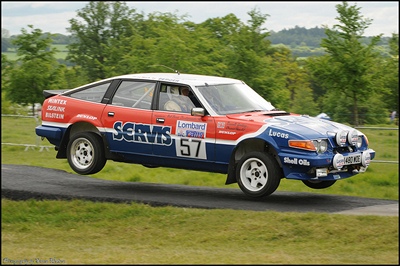Background
The competition history of the Rover Vitesse began on the race track as part of the British Touring Car Championship, before someone in the depths of the Rover Competition department envisaged it charging through the forest stages. As Tom Walkinshaw Racing (TWR) were building and running the touring car programme, it seemed to make sense for them to manage the rally project as well, especially as the Austin Rover Group’s attentions were firmly focused on the MG Metro 6R4 project.
The Rover was never going to be a lightweight spritely challenger. The bodyshell whilst being very heavy was exceptionally strong and therefore apart from the roll cage and heavy duty suspension was left largely factory standard. The engine was the obligatory Rover V8 engine that had originally powered the Triumph TR7 V8, except that development work had seen an increase in the amount of torque being produced.
One large negative arising from being heavy and having lots of torque, resulted in the strange sight of Rover engineers throwing buckets of water at the car’s rear wheels at the start of every tarmac stage. This enabled the rear wheels to spin and so gave the rear axle a chance to survive the huge amount torque being generated.
The Rover was certainly a powerful and fast car but it wasn't very nimble, although with all that torque being instantly available it was a very easy to achieve wild tail slides.
Because of the MG Metro 6R4 Group B project running at the same time (Tony Pond and Colin Malkin were starting national rallies in an early 2500cc Metro 6R4 prototype already from 1983), the Rover Vitesse 3500 wasn't seen that often. But in 1984 it still had time to celebrate dominant victories in Group A on the Hunsrück Rally and the Manx. On other occasions it challenged RWD Group B cars like the Opel Manta 400 for overall results.
The Rover Vitesse’s most famous or perhaps infamous moment came on its only works WRC start, the 1984 RAC. For the weeks leading up to the start it was impossible to open a motoring magazine without seeing an article on how the big Rover was considered to be unbeatable.
So after weeks of expectation, works driver Tony Pond, was waved away on the first stage, only to return on foot moments later having parked the car firmly in a tree less than a mile into the stage. The question was answered the car could be beaten, but only by a very large oak tree.
This Car
Is 1 of 3 identical cars prepared by Austin Rover Motorsport, for the October 1984 Austin Rover Rallysprint at Donnington. A480 WOE turned out to be the camera car, with cameras mounted on the outside and two mounted on the inside (one on the dash and the other on the centre roll cage), meaning that this car was driven on the event by Nigel Mansell, John Watson and Jimmy McRae. The latter of which recorded the fastest time .
In December 1984 ‘480’ was sold to Gooding Investments, Cardiff, who had the car rebuilt over the winter into full Group A rally specification by Bob Brain developments to compete on selected rounds of the 1985 FIA Group A challenge. After which it underwent a full rebuild by Bob Brain Developments and the advertised for sale.
After passing through a number of owners who exhibited the car at various events, it was finally purchased by Frode Saltvedt in February 1997 and exported to Norway, where the car was stored in his collection and used on one rallycross event.
In December 2006 `480`was acquired by current owner and brought back to United Kingdom, and used actively on slowly Sideways UK events.
Technical :-
Engine : 3500cc, V8, front mounted, longitudinally mounted, two single underhead camshafts, two valves per cylinder, 299 bhp
Induction : Naturally Aspirated, fuel injected
Transmission : Rear Wheel Drive, five speed gearbox

